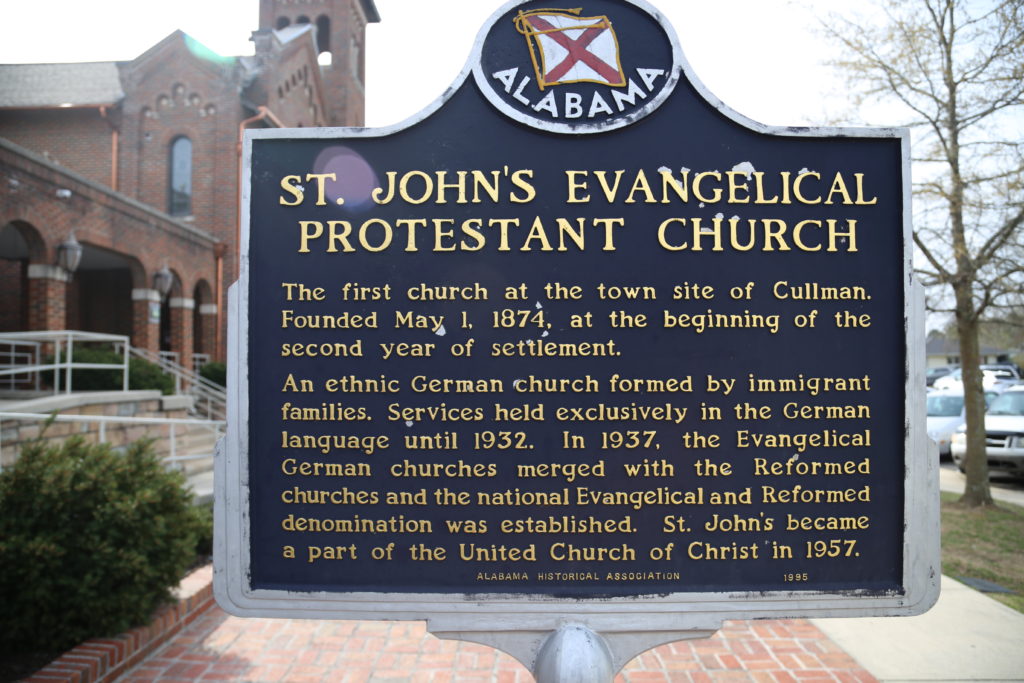Spreading God’s Word Since 1874

The history of St. John’s is linked closely to the founding and growth of Cullman itself. After the Civil War, when many people were hearing of the beautiful countryside of northern Alabama, a group of German pioneers, led by Johann Gottgried Cullmann, acted with vision and courage and moved to the area to establish a free German colony. John G. Cullman was a native of Frankweiler, Bavaria and can be considered one of America’s heroic pioneers.
In 1864, this staunch advocate of democracy came to the United States at forty-one years of age to explore the possibilities for a life in America. Having expended all the resources of his two businesses in an attempt to keep Bavaria free, Cullman was branded a revolutionary and forced to leave Germany. He first worked in Philadelphia as a clerk before moving to Cincinnati, where there was a large German population. Determined to earn enough resources to establish his colony, he studied law at night and was admitted to the bar in record time In 1871. At the prospect of cheap land, he came to North Alabama, searching for a place to settle in the Tennessee Valley and finally decided to purchase 350,000 acres on each side of the Nashville to Montgomery main line railroad. He then began recruiting German families.
The actual settlement in Cullman began in late April, 1873, with five families. By the next year, 123 families had arrived. The town was planned carefully – wide streets, parks on each side of the railway, and land designated for churches. In 1874, a year before the town was officially incorporated, Colonel Cullman and those first families founded the first religious organization in the community and the area. The church was first named First Evangelical Protestant Church (later changed to St. John’s), and a sanctuary was quickly constructed. The German families were people with deep religious backgrounds and the church quickly thrived with services all conducted in German.
In 1922, the present church sanctuary was constructed with the labor of the members and with the inspiration of God. The result was one of the most beautiful churches in North Alabama with acclaimed and appreciated stained glass windows. Services continued in German until 1932. The language was becoming a problem and lead to lessening attendance, and that year the German services were limited to twice a month. The arrangement continued until October, 1941, when they were finally discontinued.
As a rare German community in the deep South, the Evangelical Protestant Church sought German pastors first, with less consideration given to denominational ties. This commitment to ethnic heritage meant that pastors were called from a variety of backgrounds, including both ecumenically minded German Evangelicals and pastors committed to various Lutheran synods. Eventually St. John’s would affiliate with the German Evangelical Church of North America. St. John’s is proud of its heritage. The wonderful Evangelical heritage with the dignity of worship and a commitment to education showed early when the parochial school was formed in 1877. In 1931, the Evangelical influence was tempered with a merger with the Reformed Church to form the Evangelical and Reformed denomination. Then in 1957, that body merged with the Congregational Christian churches to make up the United Church Of Christ.
Today St. John’s is a part of the Evangelical Association of Reformed and Congregational Christian Churches. True to our original charter, St. John’s is a community church, and welcomes people of all denominational backgrounds and varying levels of faith who desire to seek, worship, and serve the Lord Jesus Christ.